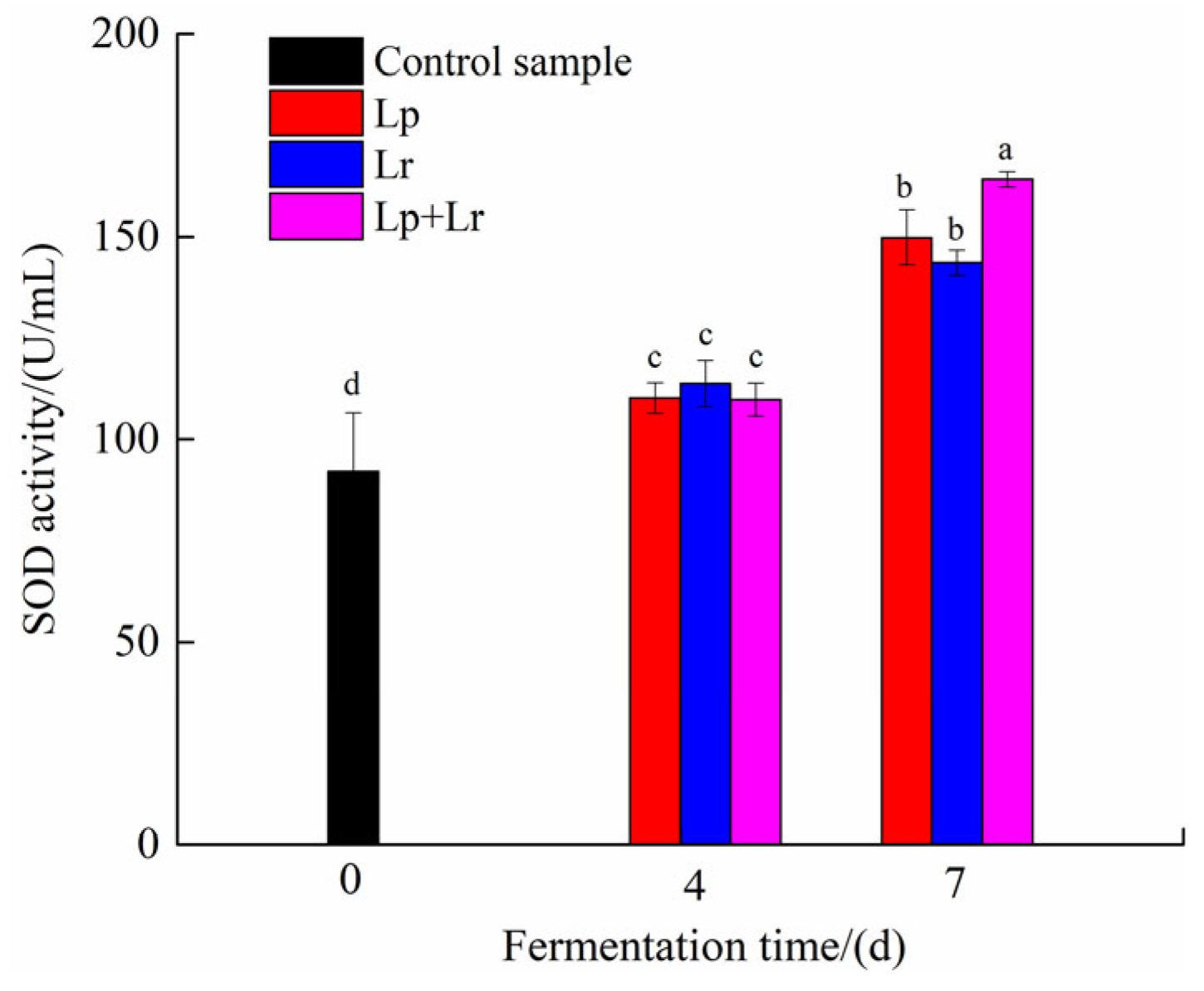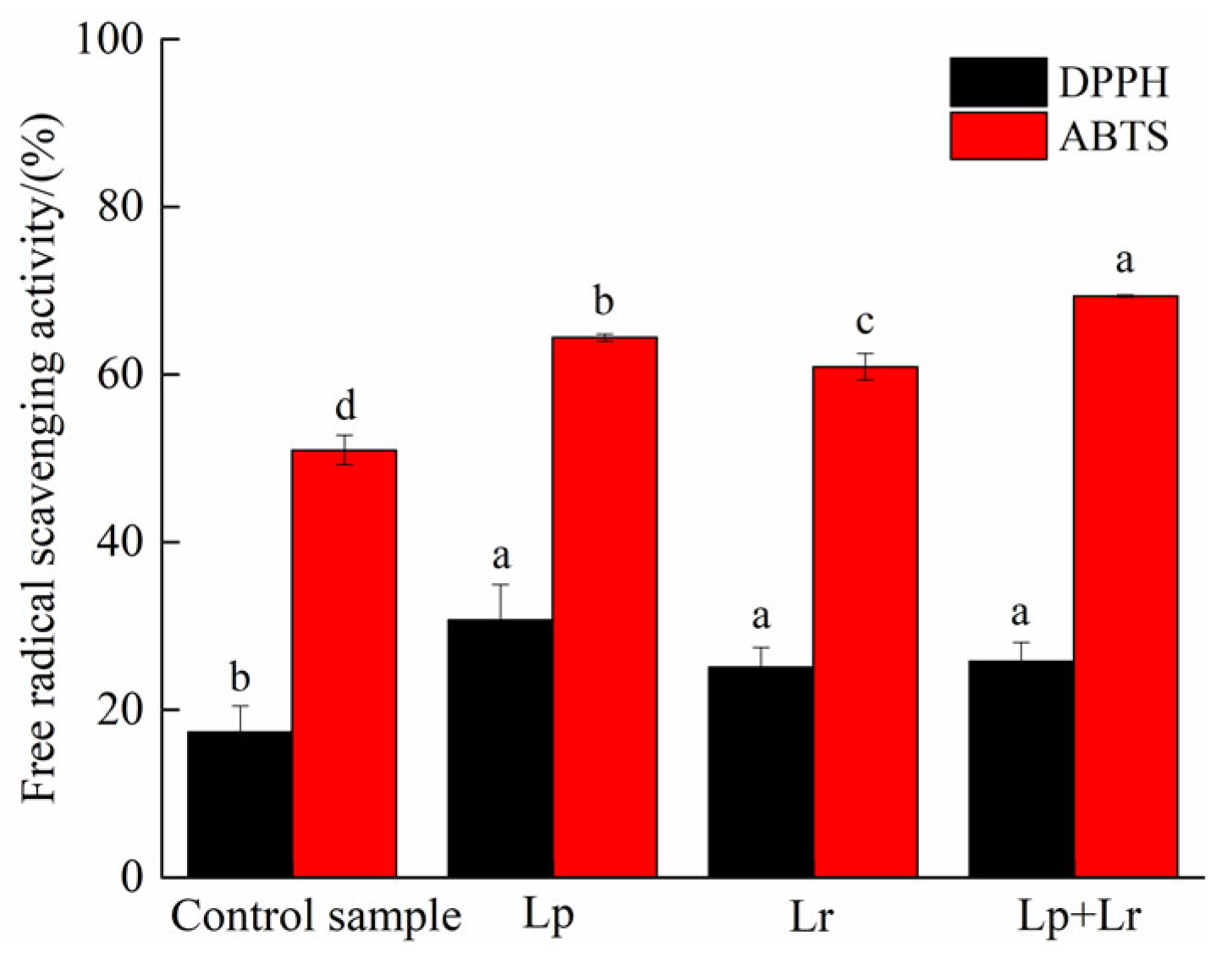Effects of Lactic Acid Bacteria Fermentation on Physicochemical Properties, Functional Compounds and Antioxidant Activity of Edible Grass
Abstract
1. Introduction
2. Materials and Methods
2.1. Materials
2.2. Edible Grass Fermentation
2.3. Determination of pH and Total Sugar Content
2.4. Determination of Total Polyphenol Content and Total Flavonoid Content
2.5. Determination of Soluble Protein Content and SOD Activity
2.6. Determination of Organic Acids
2.7. Antioxidant Activities Analysis
2.7.1. Determination of DPPH Radical Scavenging Activity
2.7.2. Determination of ABTS Radical Scavenging Activity
2.8. Statistical Analysis
3. Results and Discussion
3.1. pH and Total Sugar Content
3.2. Total Polyphenol Content and Total Flavonoid Content
3.3. Soluble Protein Content and SOD Activity
3.4. Organic Acids
3.5. Antioxidant Activity
4. Conclusions
Author Contributions
Funding
Data Availability Statement
Conflicts of Interest
References
- Chen, W. Study on nutritional value and development of edible leaf weed and research progress on edible leaf weed products. Farm Prod. Process. 2018, 7, 63–64+67. [Google Scholar]
- Lou, M.; Zhang, L.; Mei, S.; Luo, H.; Liu, Z.; Liu, D.; Hu, Z.; Chen, J.; Qu, X.; Hu, W.; et al. Study on the teratogenicity of edible grass powder on SD rats. J. Food Saf. Qual. 2021, 12, 945–950. [Google Scholar]
- Bo, L.; Yang, X. Strategic significance of edible leaf weed (protein leaf) to develop new food resources. Agric. Dev. Equi. 2018, 9, 53–55. [Google Scholar]
- Li, X.; He, T.; Yang, F.; Wang, C.; Zhou, Y.; Sha, R.; Mao, J. Analysis of nutritional components, functional components and bioactivity of edible grass. Sci. Technol. Food Ind. 2022. accepted. [Google Scholar]
- Lou, M.; Qu, X.; Zhang, L.; Liu, Z.; Hu, Z.; Wang, Y. Safety evaluation of edible grass as a new food raw material. J. Food Saf. Qual. 2021, 12, 3919–3926. [Google Scholar]
- Priscila, B.; Viva, D.T.N.M.; Rubén, L.-N.; Gaspar, R.; Carmen, F.S.; Vieira, D.C.R. Fe and Zn in vitro bioavailability in relation to antinutritional factors in biofortified beans subjected to different processes. Food Funct. 2019, 10, 4802–4810. [Google Scholar]
- Wang, L.; Zhang, H.; Lei, H. Phenolics profile, antioxidant activity and flavor volatiles of pear juice: Influence of lactic acid fermentation using three Lactobacillus strains in monoculture and binary mixture. Foods 2021, 11, 11. [Google Scholar] [CrossRef]
- Mantzourani, I.; Kazakos, S.; Terpou, A.; Alexopoulos, A.; Bezirtzoglou, E.; Bekatorou, A.; Plessas, S. Potential of the probiotic Lactobacillus plantarum ATCC 14917 strain to produce functional fermented pomegranate juice. Foods 2018, 8, 4. [Google Scholar] [CrossRef]
- Agnieszka, Z.; Barbara, S.; Marcin, B. Role of lactic acid bacteria in food preservation and safety. Foods 2022, 11, 1283. [Google Scholar]
- Quan, Q.; Liu, W.; Guo, J.; Ye, M.; Zhang, J. Effect of six lactic acid bacteria strains on physicochemical characteristics, antioxidant activities and sensory properties of fermented orange juices. Foods 2022, 11, 1920. [Google Scholar] [CrossRef]
- Yang, X.; Zhou, J.; Fan, L.; Qin, Z.; Chen, Q.; Zhao, L. Antioxidant properties of a vegetable-fruit beverage fermented with two Lactobacillus plantarum strains. Food Sci. Biotechnol. 2018, 27, 1719–1726. [Google Scholar] [CrossRef] [PubMed]
- Huynh, N.K.; Nguyen, D.H.M.; Nguyen, H.V.H. Effects of processing on oxalate contents in plant foods: A review. J. Food Compos. Anal. 2022, 112, 1–8. [Google Scholar] [CrossRef]
- Leyva, A.; Quintana, A.; Sánchez, M.; Rodríguez, E.N.; Cremata, J.; Sánchez, J.C. Rapid and sensitive anthrone–sulfuric acid assay in microplate format to quantify carbohydrate in biopharmaceutical products: Method development and validation. Biologicals 2007, 36, 134–141. [Google Scholar] [CrossRef] [PubMed]
- Kwaw, E.; Ma, Y.; Tchabo, W.; Apaliya, M.T.; Sackey, A.S.; Wu, M.; Xiao, L. Impact of ultrasonication and pulsed light treatments on phenolics concentration and antioxidant activities of lactic-acid-fermented mulberry juice. LWT 2018, 92, 61–66. [Google Scholar] [CrossRef]
- Wang, Z.; Sha, R.; Wang, G.; Xu, C.; Dai, J.; Ge, Q.; Mao, J.; Zhu, J. Simultaneous determination of twelve organic acids in edible plant source Jiaosu by HPLC. Sci. Technol. Food Ind. 2020, 41, 279–285. [Google Scholar]
- Hu, S.; Du, H. Content analysis of fatty acids and oxalic acid in ten different types of purslane (Portulaca oleracea). Guihaia 2019, 39, 1550–1557. [Google Scholar]
- Floegel, A.; Kim, D.-O.; Chung, S.-J.; Koo, S.I.; Chun, O.K. Comparison of ABTS/DPPH assays to measure antioxidant capacity in popular antioxidant-rich US foods. J. Food Compos. Anal. 2011, 24, 1043–1048. [Google Scholar] [CrossRef]
- Wu, C.; Li, T.; Qi, J.; Jiang, T.; Xu, H.; Lei, H. Effects of lactic acid fermentation-based biotransformation on phenolic profiles, antioxidant capacity and flavor volatiles of apple juice. LWT 2020, 122, 109064. [Google Scholar] [CrossRef]
- Zhou, Y.; Wang, R.; Zhang, Y.; Yang, Y.; Sun, X.; Zhang, Q.; Yang, N. Biotransformation of phenolics and metabolites and the change in antioxidant activity in kiwifruit induced by Lactobacillus plantarum fermentation. J. Sci. Food. Agric. 2020, 100, 3283–3290. [Google Scholar] [CrossRef]
- Ratchadaporn, K.; Orapin, K.; Natta, L.; Benjawan, T.; Kalidas, S. Changes in physico-chemical, astringency, volatile compounds and antioxidant activity of fresh and concentrated cashew apple juice fermented with Lactobacillus plantarum. J. Food Sci. Technol. 2018, 55, 3979–3990. [Google Scholar]
- Verón, H.E.; Cano, P.G.; Fabersani, E.; Sanz, Y.; Isla, M.I.; Espinar, M.T.F.; Ponce, J.V.G.; Torres, S. Cactus pear (Opuntia ficus-indica) juice fermented with autochthonous Lactobacillus plantarum S-811. Food. Funct. 2019, 10, 1085–1097. [Google Scholar] [CrossRef] [PubMed]
- Gao, Q.; Song, Y.; Liang, Y.; Li, Y.; Chang, Y.; Ma, R.; Cao, X.; Wang, S. Dynamics of physicochemical properties, functional compounds and antioxidant capacity during spontaneous fermentation of Lycium ruthenicum Murr. (Qinghai–Tibet Plateau) Natural Vinegar. Foods 2022, 11, 1344. [Google Scholar] [CrossRef] [PubMed]
- Haile, M.; Kang, W.H. Antioxidant activity, Total polyphenol, flavonoid and tannin contents of fermented green coffee beans with selected yeasts. Fermentation 2019, 5, 29. [Google Scholar] [CrossRef]
- Kwaw, E.; Ma, Y.; Tchabo, W.; Apaliya, M.T.; Wu, M.; Sackey, A.S.; Xiao, L.; Tahir, H.E. Effect of lactobacillus strains on phenolic profile, color attributes and antioxidant activities of lactic-acid-fermented mulberry juice. Food Chem. 2018, 250, 148–154. [Google Scholar] [CrossRef]
- Kim, D.H.; Kim, M.J.; Kim, D.W.; Kim, G.Y.; Kim, J.K.; Gebru, Y.A.; Choi, H.S.; Kim, Y.H.; Kim, M.K. Changes of phytochemical components (urushiols, polyphenols, gallotannins) and antioxidant capacity during fomitella fraxinea–mediated fermentation of toxicodendron vernicifluum bark. Molecules 2019, 24, 683. [Google Scholar] [CrossRef]
- Liu, Y.; Cheng, H.; Liu, H.; Ma, R.; Ma, J.; Fang, H.; Ferreira, I.C.F.R.; Mcphee, D.J. Fermentation by multiple bacterial strains improves the production of bioactive compounds and antioxidant activity of goji juice. Molecules 2019, 24, 3519. [Google Scholar] [CrossRef]
- Hunaefi, D.; Gruda, N.; Riedel, H.; Akumo, D.N.; Saw, N.M.M.T.; Smetanska, I. Improvement of antioxidant activities in red cabbage sprouts by lactic acid bacterial fermentation. Food Biotechnol. 2013, 27, 279–302. [Google Scholar] [CrossRef]
- Chen, D.; Liu, S.-Q. Transformation of chemical constituents of lychee wine by simultaneous alcoholic and malolactic fermentations. Food Chem. 2016, 196, 988–995. [Google Scholar] [CrossRef]
- Jyoti, B.D.; Suresh, A.K.; Venkatesh, K.V. Effect of preculturing conditions on growth of Lactobacillus rhamnosus on medium containing glucose and citrate. Microbiol. Res. 2004, 159, 35–42. [Google Scholar] [CrossRef]
- Markkinen, N.; Laaksonen, O.; Nahku, R.; Kuldjärv, R.; Yang, B. Impact of lactic acid fermentation on acids, sugars, and phenolic compounds in black chokeberry and sea buckthorn juices. Food Chem. 2019, 286, 204–215. [Google Scholar] [CrossRef]
- Mengqi, Y.; Tianli, Y.; Yahong, Y. Evolution of polyphenols and organic acids during the fermentation of apple cider. J. Sci. Food. Agric. 2014, 94, 2951–2957. [Google Scholar]
- Zhang, G.; Li, X.; Chen, W.; Chen, P.; Jin, X.; Chen, W.; Chen, H. Organic acid content, antioxidant capacity, and fermentation kinetics of matured coconut (cocos nucifera) water fermented by Saccharomyces cerevisiae D254. Int. J. Food Eng. 2018, 14, 1–13. [Google Scholar] [CrossRef]
- Chidi, B.S.; Bauer, F.F.; Rossouw, D. Organic acid metabolism and the impact of fermentation practices on wine acidity: A review. South Afr. J. Enol. Vitic. 2018, 39, 1–15. [Google Scholar] [CrossRef]
- Sun, J.; Zhao, C.; Pu, X.; Li, T.; Shi, X.; Wang, B.; Cheng, W. Flavor and functional analysis of Lactobacillus plantarum fermented apricot juice. Fermentation 2022, 8, 533. [Google Scholar] [CrossRef]
- Hur, S.J.; Lee, S.Y.; Kim, Y.-C.; Choi, I.; Kim, G.-B. Effect of fermentation on the antioxidant activity in plant-based foods. Food Chem. 2014, 160, 346–356. [Google Scholar] [CrossRef]








| Organic Acids | Calibration Curve | R2 |
|---|---|---|
| Lactic acid | y = 4.49 × 106x − 3.83 × 103 | 0.9965 |
| Malic acid | y = 5.7 × 106x + 1.11 × 104 | 0.9951 |
| Citric acid | y = 4.72 × 106x − 2.53 × 104 | 0.9968 |
| Succinic acid | y = 3.28 × 106x − 9.18 × 103 | 0.9968 |
| Organic Acids | Fermentation Time/(d) | |||
|---|---|---|---|---|
| 0 | 4 | 7 | ||
| Lactic acid | Lp | 0.115 ± 0.016 d | 2.149 ± 0.341 b | 2.364 ± 0.294 b |
| Lr | 3.877 ± 0.280 a | 3.633 ± 0.369 a | ||
| Lp + Lr | 2.452 ± 0.536 b | 1.286 ± 0.323 c | ||
| Oxalic acid | Lp | 2.423 ± 0.015 a | 2.061 ± 0.109 b | 0.757 ± 0.003 d |
| Lr | 2.029 ± 0.012 b | 0.738 ± 0.016 d | ||
| Lp + Lr | 1.633 ± 0.055 c | 0.582 ± 0.006 e | ||
| Malic acid | Lp | 0.926 ± 0.182 a | 0.315 ± 0.086 b | 0.363 ± 0.108 b |
| Lr | 0.151 ± 0.027 c | 0.150 ± 0.019 c | ||
| Lp + Lr | 0.148 ± 0.078 b | 0.371 ± 0.159 b | ||
| Citric acid | Lp | 0.182 ± 0.079 a | 0.117 ± 0.011 b | 0.129 ± 0.011 b |
| Lr | 0.092 ± 0.048 b | 0.129 ± 0.011 b | ||
| Lp + Lr | 0.115 ± 0.001 c | 0.157 ± 0.036 b | ||
| Succinic acid | Lp | 0.107 ± 0.026 b | 0.343 ± 0.085 a | 0.343 ± 0.085 a |
| Lr | 0.253 ± 0.120 b | 0.435 ± 0.071 a | ||
| Lp + Lr | 0.147 ± 0.051 b | 0.479 ± 0.183 a | ||
| Total organic acids | Lp | 3.753 ± 0.318 de | 4.985 ± 0.632 bc | 3.956 ± 0.501 cd |
| Lr | 6.402 ± 0.487 a | 5.085 ± 0.486 b | ||
| Lp + Lr | 4.495 ± 0.721 bcd | 2.875 ± 0.707 e | ||
Publisher’s Note: MDPI stays neutral with regard to jurisdictional claims in published maps and institutional affiliations. |
© 2022 by the authors. Licensee MDPI, Basel, Switzerland. This article is an open access article distributed under the terms and conditions of the Creative Commons Attribution (CC BY) license (https://creativecommons.org/licenses/by/4.0/).
Share and Cite
Li, X.; He, T.; Mao, J.; Sha, R. Effects of Lactic Acid Bacteria Fermentation on Physicochemical Properties, Functional Compounds and Antioxidant Activity of Edible Grass. Fermentation 2022, 8, 647. https://doi.org/10.3390/fermentation8110647
Li X, He T, Mao J, Sha R. Effects of Lactic Acid Bacteria Fermentation on Physicochemical Properties, Functional Compounds and Antioxidant Activity of Edible Grass. Fermentation. 2022; 8(11):647. https://doi.org/10.3390/fermentation8110647
Chicago/Turabian StyleLi, Xianxiu, Tao He, Jianwei Mao, and Ruyi Sha. 2022. "Effects of Lactic Acid Bacteria Fermentation on Physicochemical Properties, Functional Compounds and Antioxidant Activity of Edible Grass" Fermentation 8, no. 11: 647. https://doi.org/10.3390/fermentation8110647
APA StyleLi, X., He, T., Mao, J., & Sha, R. (2022). Effects of Lactic Acid Bacteria Fermentation on Physicochemical Properties, Functional Compounds and Antioxidant Activity of Edible Grass. Fermentation, 8(11), 647. https://doi.org/10.3390/fermentation8110647






